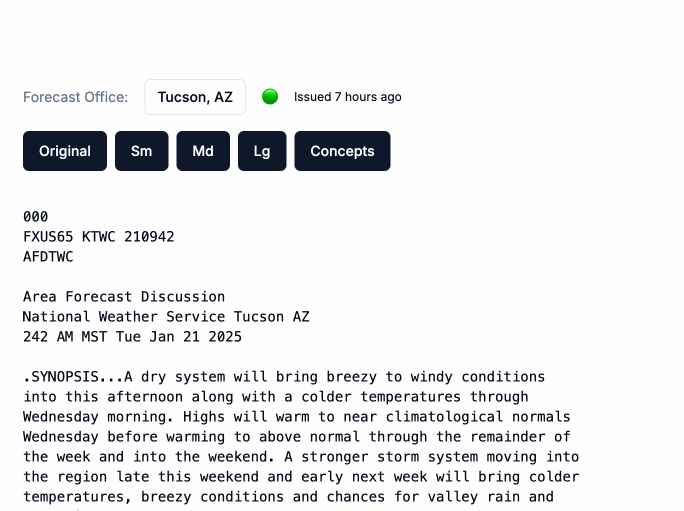Growing up in Kansas, I developed a natural interest in meteorology — there's nothing quite like watching a springtime thunderstorm roll across the prairie. Each place I've lived since has had its own unique weather personality, like the "40/70 benchmark" that New Yorkers use to predict if a nor'easter will bring snow or rain, or Los Angeles's notorious Santa Ana winds.
Recently, I built a small app to help me better understand the weather in my new home of Tucson, Arizona. The app lets me read and interact with the National Weather Service's Area Forecast Discussion (AFD) — a technical but conversational document where meteorologists explain their forecast reasoning. While building it, I stumbled onto something interesting about how AI might help us learn in more natural and effective ways.
Making Technical Knowledge Accessible
The app itself is fairly simple. It pulls in the latest AFD from my local National Weather Service office and adds an AI-powered layer of interpretation on top. I can highlight any sentence to get an explanation of its meaning in the broader context of the discussion. I can generate summaries of different lengths, from a quick one-liner to a detailed three-paragraph explanation. The application also extracts key meteorological concepts, explains them, and generates questions to deepen understanding.
Here, we see the app in action, explaining what a "split flow" is, and the implications for the forecast:

I originally built this to test a hypothesis that brief text summaries might be more useful than the array of temperatures and precipitation icons that most weather apps use. But as I started using the app regularly, I realized I was starting to learn meteorological concepts "in the wild." Instead of reading an article about the patterns that influence weather in Tucson, I'm learning about them in the context of today's actual conditions and tomorrow's real forecast.
When Context Meets Understanding
This experience connects to an idea that Andy Matuschak wrote about: "bringing guided learning to authentic contexts." Traditional learning often separates study from practice — we read textbooks or take classes, then try to apply that knowledge later. But some of our best learning happens when we're immersed in real situations where the knowledge matters.
My weather app accidentally created this kind of immersive learning environment. I'm not studying meteorology because I want to be a professional forecaster. I'm learning it because I'm curious about what's happening outside my window. The AI layer helps bridge the gap between technical knowledge and practical context.
Opportunities for Natural Learning
This approach opens up possibilities in many contexts where we interact with technical or specialized information. In fact, we're already seeing similar ideas emerge in different domains.
Take Rebind, a new venture that's adding AI-powered expert commentary to classic literature. They've created digital versions of canonical texts where readers can engage in dialogue with AI versions of renowned authors and scholars about the works they're reading. Margaret Atwood can guide you through A Tale of Two Cities, or Bill McKibben can help you understand the nuances of John Muir's My First Summer in the Sierra - right at the moment when you encounter something puzzling or interesting in the text.
This is exactly the kind of in-context learning layer I stumbled upon with my weather app - it helps bridge the gap between consuming content and understanding it deeply. Instead of reading a literary analysis after-the-fact, Rebind lets readers learn about literature while they're actually reading it.
The possibilities for this kind of contextual learning layer extend into many other areas. Imagine investors understanding financial statements through personalized explanations, or residents grasping zoning proposals through examples from their own neighborhood. The key is that in each case, the learning happens naturally as part of doing something we already care about. AI isn't replacing human expertise — it's adding a layer of interpretation that helps us build understanding through real-world engagement.
What contexts in your life could benefit from this kind of in-the-moment learning layer? I'd love to hear your thoughts and examples.